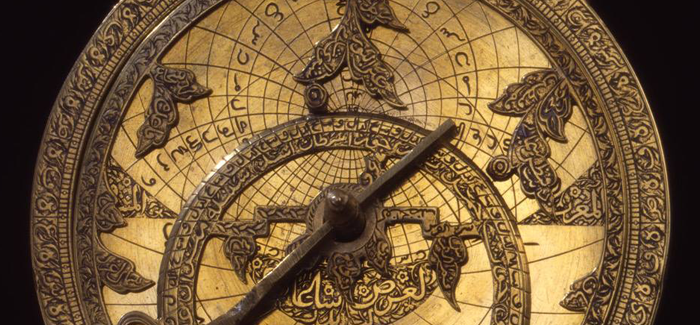
This brass astrolabe from Iran was probably not used for navigation on the Silk Road, but for Muslim travelers to find qibla, the direction to Mecca. (OIM A4091, Oriental Institute)
A long, strange trip.
Apparently, neither “Silk” nor “Road” is quite accurate. In “Silk Road and Indian Ocean Traders: Connecting China and the Middle East,” Tasha Vorderstrasse, a research associate at the Oriental Institute, gave a brief history of the trade route. The Gallery Talk was part of both OI’s Lunchtime Traveler Series and Envisioning China, a festival of art and culture presented by UChicago Arts.
[[{"type":"media","view_mode":"media_original","fid":"1449","attributes":{"alt":"","class":"media-image","height":"345","typeof":"foaf:Image","width":"460"}}]]
Although featured in the display case for the Silk Road Gallery Talk, silk was only one of the items that made its way along the historic trade route. (Photography by Jeanie Chung)
According to Vorderstrasse, silk was only one of the many items⎯along with opium, spices, porcelain, even religion and technology⎯carried by traders along what was not so much one road as a network of roughly parallel routes, in various directions around the Black and Caspian Seas. Many explorers also traveled by ship, although, as Vorderstrasse pointed out, “It wasn’t quite as exciting to go hang out in the middle of the Indian Ocean.”
Here are five more things I learned about the Silk Road:
1. Marketing works. Explorers like Marco Polo were drawn to exotic-sounding locales like Samarkand and Bukhara, “and went so that they could write their travel memoirs⎯or die, which made it even more romantic,” said Vorderstrasse.
2. The dying part is not an exaggeration. Traveling the 4,000-mile route meant dealing with cold, heat, thirst, hunger, and barbarians to boot. Vorderstrasse read a poem about the Silk Road by a ninth-century Chinese poet that included the line, “I, who have never wept in my life, have now shed a thousand tears.”
3. The Mongol Empire wasn’t all bad. In addition to facilitating trade along the way when they brought workers from Central Asia to China, the Mongol conquest of much of the region in the 13th century meant that travelers only had to deal with one set of customs and regulations. Although, as Vorderstrasse admitted, “Obviously, if you resisted, they killed you rather nastily.”
4. Some imports were wildly popular ... Changsha and other Chinese ceramics were status objects for Europeans and people in the Middle East. Given the high cost of transporting them, locals tried to make their own lookalike versions, which were rarely successful. Paper was also a big hit, replacing papyrus in Egypt in the middle of the eighth century.
5. ... but not all. When a city in what is now Iraq tried to follow China’s lead and use paper money instead of coins, not even the threat of beheading could convince its citizens to switch.
